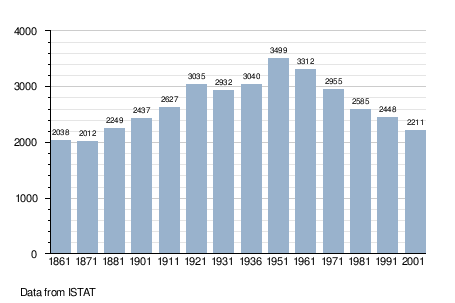Altare
| Altare | |
|---|---|
| Comune | |
| Comune di Altare | |
|
Saint Eugene Church | |
 Altare Location of Altare in Italy | |
| Coordinates: 44°20′10.32″N 08°21′38.4″E / 44.3362000°N 8.360667°ECoordinates: 44°20′10.32″N 08°21′38.4″E / 44.3362000°N 8.360667°E | |
| Country | Italy |
| Region | Liguria |
| Province / Metropolitan city | Province of Savona (SV) |
| Government | |
| • Mayor | Giuseppe Flavio Genta |
| Area | |
| • Total | 11.7 km2 (4.5 sq mi) |
| Elevation | 398 m (1,306 ft) |
| Population (2011) | |
| • Total | 2,162 |
| • Density | 180/km2 (480/sq mi) |
| Demonym(s) | Altaresi |
| Time zone | CET (UTC+1) |
| • Summer (DST) | CEST (UTC+2) |
| Postal code | 17041 |
| Dialing code | +39 019 |
| Patron saint | S.Rocco |
| Saint day | 16 August |
| Website | Official website |
Altare is a comune (municipality) in the Province of Savona in the Italian region Liguria, located about 45 km (28 mi) west of Genoa and about 11 km (6.8 mi) northwest of Savona. As of 1 January 2009, it had a population of 2,160[1] and an area of 11.7 km2 (4.5 sq mi).[2]
Altare borders the following municipalities: Cairo Montenotte, Carcare, Mallare, Quiliano, and Savona.
Geography
Altare is just west of the Colle di Cadibona ("Cadibona Hill"), which at 459 m (1,506 ft)[3] divides the Ligurian Alps from the Ligurian Apennines. Also called the pass at Cadibona or the pass at Altare it is accessed from the coast by the Via Nazionale Piemonte, coming up from Savona and crossing into Piemonte in the north Italian plain.
Demographics
The population of this mountain community, recorded for modern times by ISTAT, has remained perennially at about 1100 families living in as many dwellings. Its size is limited to a large degree by the mountainous environment.

Altare includes a population recognizing a distinct identity and calling itself the Università d'Altare, or the Monsu, as opposed to the paesani, the rest of the population. Although currently Christian, it descends from a Sephardic Jewish community of glassmakers who found refuge in the mountains several hundred years ago. They maintained themselves as a ghetto, often self-governing, until the 19th century. At that time they were more completely assimilated, except for their traditional self-distinction. The Museum of Glass in Villa Rosa at Altare preserves many pieces of fine glass produced during this tradition.[4]
References
- ↑ "Demography in Figures". Istituto nazionale di statistica (ISTAT). August 2009.
- ↑ "City of Altare". comuni-italiani.it.
- ↑ The altitude is embossed on the plaque that marks the summit of the pass.
- ↑ Kurinsky, Samuel. "The Glassmakers of Altare". Hebrew History Federation (HHF). Archived from the original on 10 April 2010. Retrieved 7 March 2010.